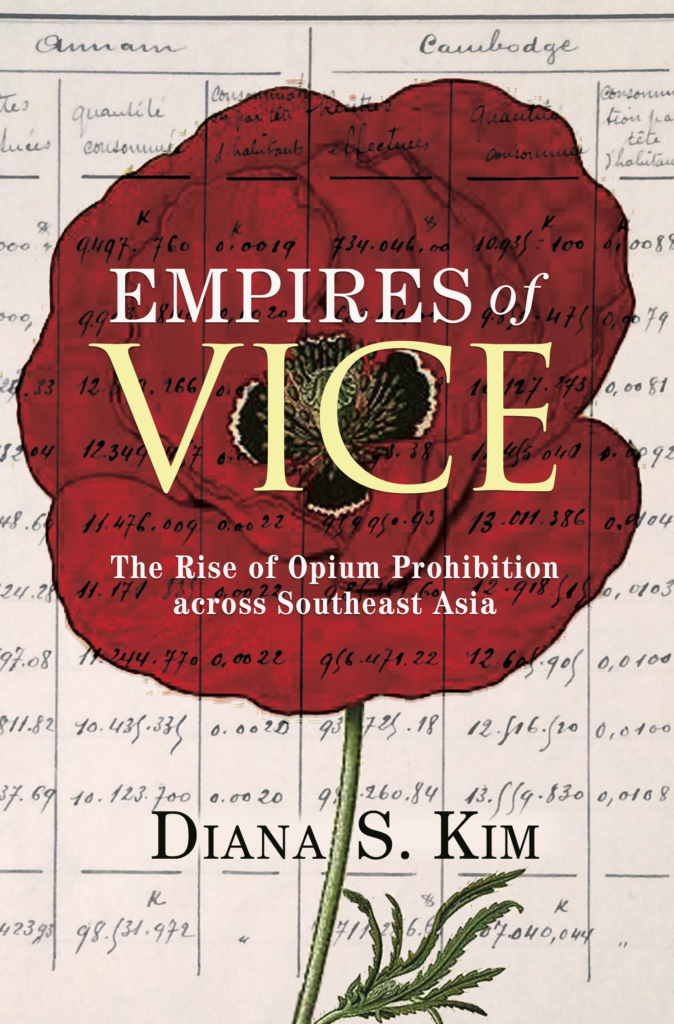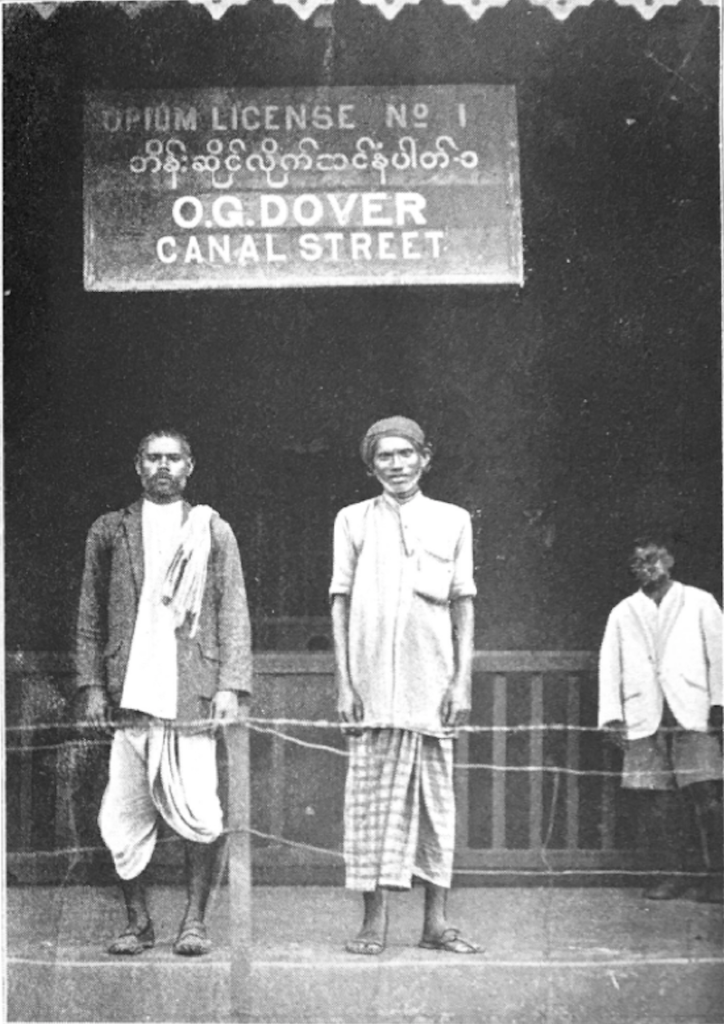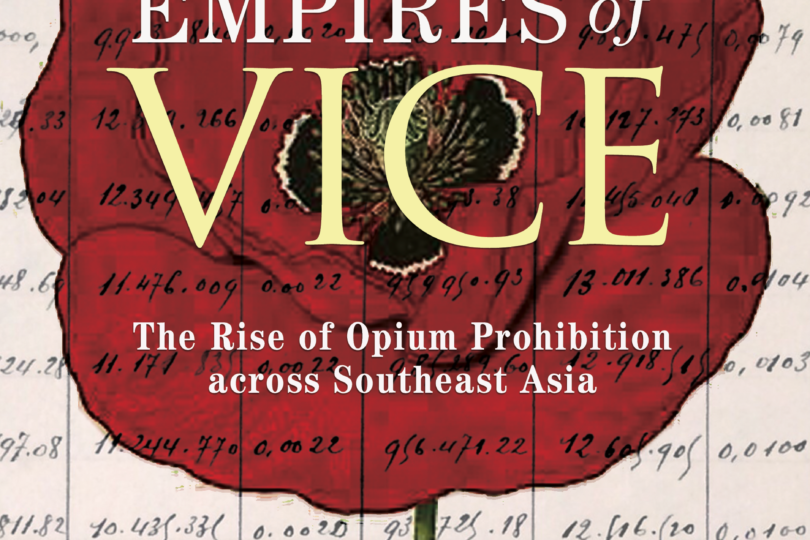Editor’s Note: The Docket recently interviewed Diana Kim about her new book, Empires of Vice: The Rise of Opium Prohibition Across Southeast Asia. She was kind enough to offer a detailed glimpse at her book, where it came from, and what the future holds.
The Docket: First of all, thank you for taking the time to talk with us about your new book. Let’s start with a topic that is important to many of our readers: the state. Given the ‘statist turn’ in so many literatures these days–the state is back in!–I think a lot of our readers will be fascinated by the story you tell in this book about law and governance in Southeast Asia. But before we get into that, how did you get interested in opium prohibition in particular?

DSK: Empires of Vice is a book about the inner life of a bureaucratic state, told through the history of opium prohibition across Southeast Asia since the 19th century. Yet, some of its earlier formative ideas came from a much more contemporary angle, on a very different topic: HIV/AIDS in Thailand. I was intrigued by the country’s globally lauded “success story” in addressing the epidemic during the early 1990s, especially concerning sex workers and injecting drug users. As a graduate student, I initially envisioned a dissertation comparing Thailand to neighboring Burma and Laos. But what I soon realized was that underlying much of the cross-country policy variations, there was a deeper commonality. They all had extremely harsh narcotic laws even though they had all once relied heavily on taxes levied on legal opium markets. I found such a total volte-face on opium fascinating, especially as I came to understand how many other countries in Southeast Asia—Singapore, Malaysia, Indonesia, Vietnam, Cambodia—also shared this reversal, which occurred during the heyday of colonial expansion even though opium was a significant source of revenue for empires. And Southeast Asia’s anti-opium turn became even more puzzling, as I realized how much of a doubly overlooked and misunderstood historical event it was, which specialists of the region tended to take for granted while experts of global drugs were not even aware that it had occurred at all. For me, understanding opium prohibition became a way to pose and explore larger questions about how states can transform their economic foundations and claims to authority, while masking the very process through which such change occurs.
The Docket: This is a beautiful book! The cover is dazzling, and your prose jump off the page. But I’m sure it was a long and difficult process to get here. Can you walk us through what it was like to do the research for this book? Many of our readers will be familiar with the National Archives in Great Britain and the United States. What was it like working at the National Archives of Myanmar, though? And how about the Vietnamese National Archives?
DSK: Thank you! The cover image is a poppy flower overlaid on an opium ledger for French Indochina that I encountered at France’s National Archives for Overseas Territories (Archives nationales d’outre mer) in Aix-en-Provence (FM/INDO NF/88, dossier 880). Leslie Flis at Princeton University Press deserves much credit for the jacket design.
If you look closely at the cover, the ledger’s headings read: opium revenue (recettes effectuées), total opium consumption (quantités consommée), and per capita opium consumption (consommation par tête d’habitant), and these are for the territories that comprise today’s Cambodia, Vietnam, and Laos. The numbers at the top are for 1899, moving down until 1908, and the last entries are summary totals for each territory’s revenue and consumption volume. The ledger came from a 1908 report by an Inspector of Colonies named Maurice Méray; and in a sense, a lot of my research for this book involved excavating the stories behind these types of official records, exploring who produced the numbers and labels; when and how, based on what information, biases, and claims to authenticity and truth (or lack thereof). I was curious about the nitty-gritty bureaucratic decision-making practices and processes that created them. Men like Inspector Méray, effectively an auditor sent from metropolitan France to inspect the colony’s books, necessarily saw a partial, neat, summary version of Indochina’s colonial state-opium market relationships—as exemplified by this ledger. I wanted to better understand the “raw” material before “cooked” official records.
I spent around 22 months at different repositories in Southeast Asia and Europe, of which large amounts of time involved chasing administrators in the archives and trying to piece together their ways of depicting and reporting on problems relating to opium. My main focus was on fiscal regulation, but it became evident that records on opium taxation were inseparable from records on customs, immigration, jails and prisons, public hygiene, finance and banks, partly because of the peculiarly imprecise and complex ways that opium consumption had long been taxed as a colonial vice. While it was exciting to encounter such a rich bureaucratic archive on opium (which I had initially worried might be inaccessible given the sensitive nature of drug policy today in Southeast Asia), research was also challenging because the records were often fragmentary, might mention opium only in passing or buried in minutiae of bureaucratic procedure, and the administrative archives spanned so many levels that were linked but in non-obvious ways. It sometimes felt like chasing the White Rabbit down a rabbit hole.
For instance, I found how Meray’s report and those of subsequent Inspectors grappled unsuccessfully with fictitious opium sales numbers (called cessions fictives) that the colony’s directors of customs and excise reported, which misrepresented the nature of opium consumption (because per capita consumption was calculated based on total opium sales volume divided by Indochina’s population). Then, in chasing those directors of customs and excise, their secretaries and lower-level officers, I saw draft reports and internal correspondences giving reasons why such numbers were had been misreported, which pointed toward emergency funds and overdrawn spending accounts for importing opium from India and China since the 1910s that led to debt crises in the 1920s, as well as a really odd situation by the 1930s in which tons of rotting opium had been stashed in the basement of the Bank of Indochina in Hanoi. Which in turn set me off on tracking down the administrators who had designed those emergency funds, done the paperwork and accounting, as well as who from the Bank of Indochina had been involved in such an ill-conceived endeavor and why… This story eventually became a part of Chapter 5, entitled “Disastrous Abundance in French Indochina.” Given the multi-level nature of administrative records and their incompleteness in any given repository, I moved back and forth between Aix, Hanoi (Vietnam’s National Archives, Center No. 1), Phnom Penh (National Archives of Cambodia) and similar ways in Rangoon and London for the archives of the British in Burma as well as the Straits Settlements and Malay States (today’s Singapore and Malaysia). Works by Ann Stoler, Iza Hussin and Jonathan Saha were especially important for how I understood the nature of colonial archives and underlying architecture of knowledge production and networks linking and disconnecting different repositories. On a more practical note, I have written elsewhere about my own experience navigating national archives across Southeast Asia as well as in Britain and France as a foreign researcher grappling with pragmatic payoffs, issues of privilege and reasons for humility when conducting multi-site archival research.
The Docket: In your introduction, you include this beautiful quote from the novelist and scholar Amitav Ghosh, that when consumed opium was “at once bountiful and all devouring, merciful and destructive, sustaining and vengeful.” This was also evocative of Walter Benjamin’s thoughts about hashish. You also give us some pretty funny, colorful language from local critics, such as “Simple Simon” (147). This contrasts, of course, with the cold, technical language of imperial administrators. How much of a challenge was it to have to bridge these linguistic worlds as you assembled this narrative?
DSK: The central protagonists of my book are administrators from Britain and France stationed locally in Southeast Asia, especially those involved in an institution called the opium monopoly (or régie). Between the 1890s and 1940s, opium monopolies were introduced in every European-ruled territory for the region, and these institutions effectively centralized state control over opium markets, replacing previous tax farming systems, and narrowing the boundaries of what defined legal and legitimate commercial activity relating to opium. And while the opium monopolies were formally under Departments of Custom and Excise or Finance, because the drug was so sprawled across every aspect of colonial governance, the formal purview these institutions extended to matters of prison administration (when criminals were opium smokers), labor and immigration (when the ability of migrant workers consuming opium was at stake), as well as customs and border policing (when opium smokers, suppliers, and their paraphernalia moved in and out of jurisdictions).

The opium monopolies were often maligned and criticized by the press, intellectuals, medical experts, social activists, moral crusaders and other anti-opium forces as well as metropolitan bureaucrats and politicians. One reason lies with the official language of prohibition that involved administrators used, claiming to be incrementally restricting opium, limiting harmful consumption but not yet totally shutting down existing markets and continuing to collect opium revenue. So from the outside, many regarded such language as insincere rhetoric, mere justifications for emboldening state control, likely covering up more insidious intents such as bureaucratic corruption or callous disregard for colonized subjects, and indeed pure hypocrisy of a European ruler toward the most vulnerable of non-European subjects. For instance, “Simple Simon,” as you note, calls out the British administrator Arthur Meek Pountney—who designed an opium revenue replacement reserve fund for the Straits Settlements—mocking him as authoring a suspicious arrangement for which “[t]o be plain, Sir, I smell a rat, not perhaps, to mix species so active as a musang or so penetrating as a durian, but still a rat.” Comparisons to the stench of animals or pungent fruits, analogies to “a double-headed monster” that poisoned natives (p. 81), as well as vehement denunciations of wayward administrators as ungentlemanly rentiers or even addicts to the wealth of opium colored the language of critique against the European opium monopolies in Southeast Asia.
I wanted to better understand the insider’s perspective, and what was going on inside of these deeply maligned institutions. When one takes seriously the actors within a colonial bureaucracy, official language takes on a different texture, never as coherent, never as well-planned out, and thus never something simply deceptive and misleading of any “real intent.” For this line of reasoning, I drew much methodological inspiration from different disciplines, including the brilliant works of historian Bhavani Rahman in Document Raj to grapple with the significance of bureaucratic paperwork discretionary authorship, critical theorist and legal scholar Bernard Harcourt as well as political scientist and sociologist Kimberly Morgan and Ann Orloff to critically assess why we prefer certain analytical constructs about the state, and what they capture, omit, and mask about their empirical referents. Suspending my own presumptions about local administrators as having given interests or were constantly hiding something helped me read the archives of the opium monopoly, not though a narrow lens of avarice and greed, but in a more flexible way that could also weigh the expressed anxieties, frustration, sense of remorse and atonement, pride, confidence, boredom, skepticism; all of these sentiment that suggested a way to see deep ambivalence on the part of administrators inside the opium monopoly about the very institution that they were tasked with sustaining. I was both pleasantly surprised and disturbed to realize how this allowed me to contextualize, rather than dismiss, vocabularies and administrative ways of reasoning that were also often colorful, sometimes funny, and certainly full of mixed metaphors and dramatic analogies, even in the more formal of official records, such as serialized annual reports on excise or prison administration, in ways that unsettle how we typically think of bureaucratic language as dull and technical. One of the interesting challenges I faced when reconstructing these bureaucratic narratives involved deciding how much of an individual administrator’s personal, professional, social, and political background to include. Some had extraordinarily sensational experiences while on the job, such as Malcolm Chisholm, Chief Excise Commissioner for Moulmein in Burma who was accused of tattooing his Burmese mistress on the forehead with the words “prostitute.” Others had service records unmarred by any scandal or notable accomplishments. Some administrators were deeply pious, with close connections to the powerful Society for the Suppression of the Opium Trade, while others propounded more secular, scientific minds fascinated by the precision of mathematics (as was the case of Arthur Pountney, mocked by “Simple Simon”), Social Darwinism and eugenics, as well as the authority of public health. I opted to err on the side of including less, because the larger story I wanted to convey was about the inner workings of the colonial bureaucracy rather than the humanity of its agents. I also wanted to avoid giving more coherence to administrative narratives of the opium monopoly than I saw in evidence. So, I endeavored to anchor local administrators in the likely informational environment available to them in their official capacities, and then reconstruct and embed their small, often narrow but still complex worlds of ideas in the broader intellectual, political economic contexts of their day.
The Docket: The book ends roughly in the 1940s, as Southeast Asia became entangled in a world of “counterinsurgency and political struggles,” in conjunction with “drug wars and criminalization of activities relating to…opium” (198). If you had the chance to write chapter 9, what do you think that story would look like?
DSK: Just to first provide a brief overview of this book. Chronologically, it spans eight decades of British and French rule in Southeast Asia, beginning in the 1870s and ends soon after World War II. Structurally, it takes a telescope-like approach that starts from a general picture, zooms into specific sites, and then pulls back to reexamine the original picture.
In Part I (Chapters 1, 2 &3) I introduce colonial opium prohibition as a puzzle of state transformation, unpacking the question of how European colonial states across Southeast Asia were able to ban opium consumption, a once permissible vice that they had taxed and justified collecting revenue from. The answer, I argue, lies with colonial bureaucracies, especially administrators on the ground who inadvertently constructed official problems relating to opium that escalated and posed internal challenges to stability and legitimacy of colonial governance. I further underscore how Southeast Asia’s experience with taxing opium consumption sits uneasily against prevailing scholarship that explain anti-opium reforms in light of moral crusaders and changing international norms because they focus mainly on India and China’s experiences with trade and production. Part II (Chapters 4, 5 & 6) take deep dives into the inner lives of opium-entangled bureaucracies of British Burma, Malaya (mainly the Straits Settlement of Singapore) and French Indochina. Each chapter traces processes through which local administrators of monopolies came to construct official problems relating to the social, fiscal, and financial life of opium, and how they shaped major anti-opium reforms. Part III (Chapters 7 & 8) returns to the larger picture of opium prohibition across Southeast Asia, showing how the monopolies persist during World War II , with lasting implications for postwar reconstruction and decolonization into the 1950s. If adding Chapter 9, I would love to tell a longer story about the legacies of colonial opium prohibition that reaches into the 1970s, when nearly all of Southeast Asia’s countries introduce capital punishment for drug-related offenses. I would also zoom out further to situate Southeast Asia in a transnational context that includes interlocking legacies of Japanese imperial approaches to opium in East Asia, the United States’ global war on drugs as well as connections to more general smuggling and trafficking dynamics across the Arabian Sea, the Middle East and North Africa, and China. For Empires of Vice, I adopted a specifically region-centered focus because I felt it important to illuminate Southeast Asia’s surprisingly forgotten and misunderstood experience with opium consumption, which is too often shadowed by the famed histories of opium wars, trade and poppy cultivation in India and China. But, of course, this region was always and densely linked to other sites with their own complex economies of opium, varied histories of state involvement and moralizing politics that bear different imprints of imperial rule. Perhaps (or rather obviously), this may take more than a chapter… For now, I’m excited about a vibrant emerging research trend among historians of Southeast Asia that explore the postcolonial period and/or take bold transnational approaches such as Christian Lentz’s article on opium taxation by the Democratic Republic of Vietnam, Anne Foster’s work on the American empire in the Philippines and opium’s trans-imperial journey, works by Patrick Meehan and John Buchanan on postwar opium production in the Shan States and Claire Edington’s new project on drug addiction in Vietnam and global health, just to name a few.
The Docket: Let’s step away from this book for a moment to talk about the future. What are you up to next?
DSK: I currently developing a second book-length project that moves away from the topic of drugs and vice specifically, but continues to explore questions about how relationships between states and people deemed vulnerable and marginalized emerge and evolve. My particular interest lies with the historical regulation of “untouchability” and problems of stigma across Asia, which I hope to approach in ways that sheds light on the making of illicit global labor economies.


